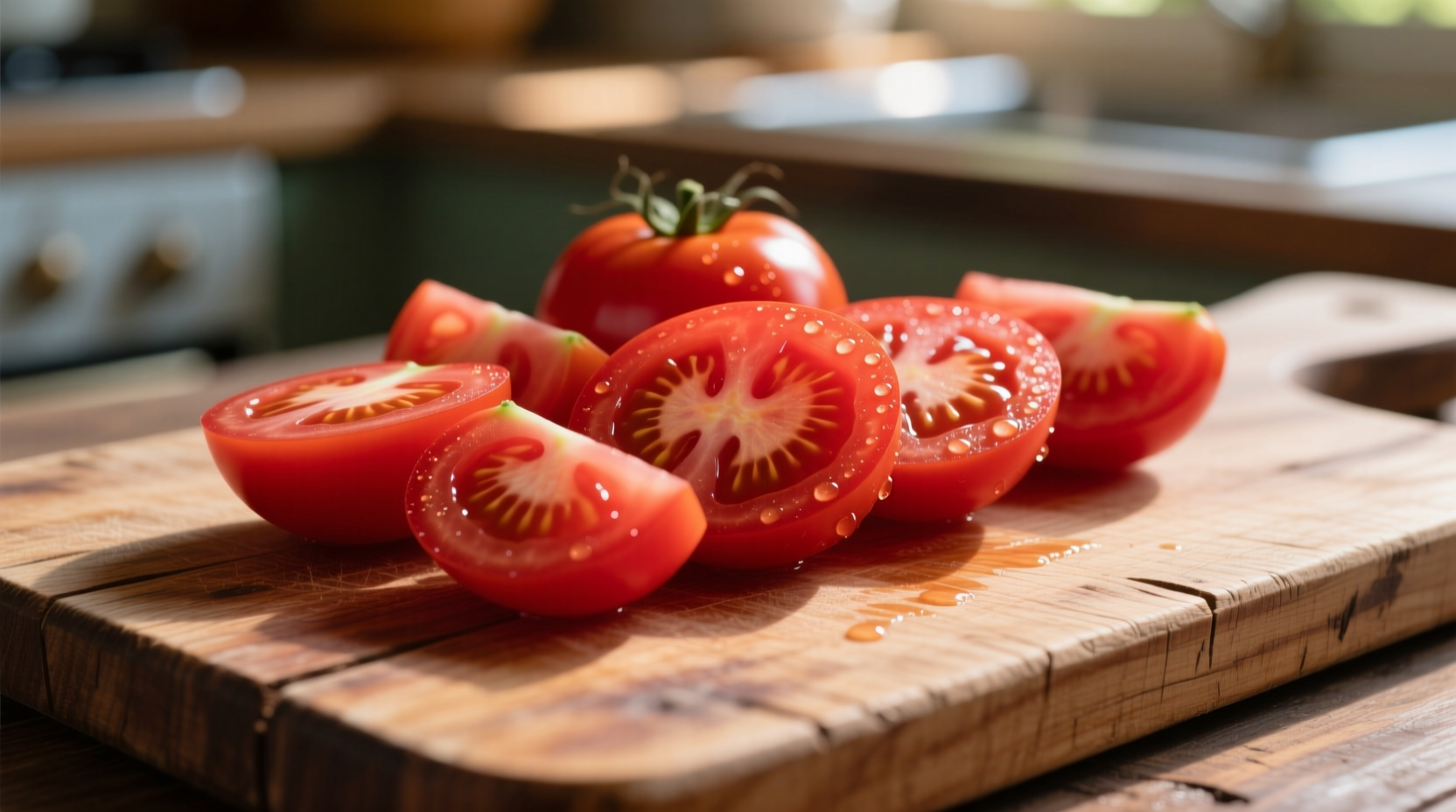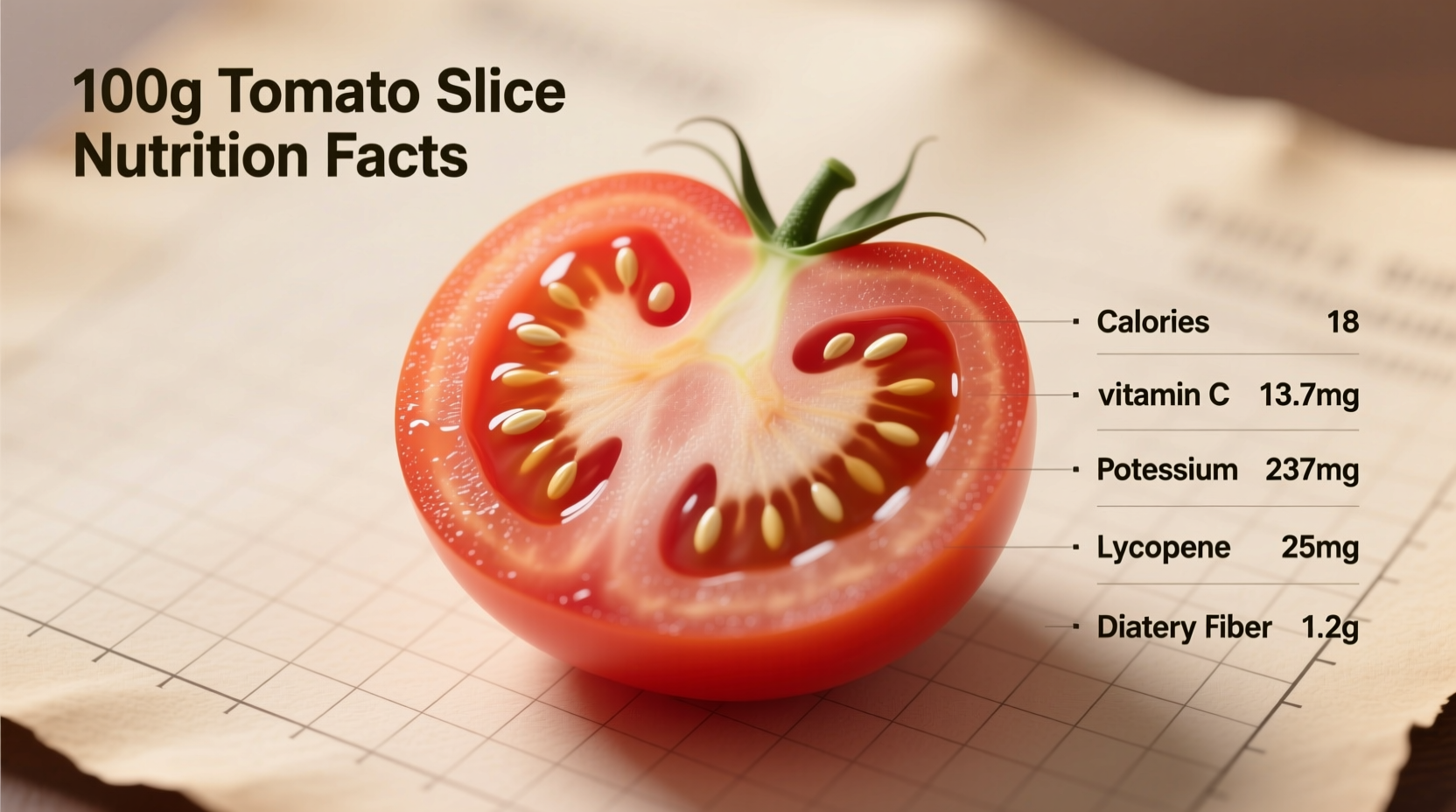When you reach for those vibrant red tomato slices on your salad or sandwich, you're making a smart nutritional choice backed by decades of dietary research. These juicy slices deliver essential vitamins and minerals with minimal caloric impact, making them a staple in heart-healthy Mediterranean diets worldwide. Let's explore exactly what makes tomato slices such a valuable addition to your daily meals.
Nutritional Profile of Fresh Tomato Slices
Understanding the precise nutritional composition of tomato slices helps you make informed dietary decisions. Unlike processed tomato products, fresh slices maintain their natural nutrient profile without added sugars or sodium.
| Nutrient | Per 100g | % Daily Value* |
|---|---|---|
| Calories | 18 kcal | 1% |
| Total Fat | 0.2 g | 0% |
| Carbohydrates | 3.9 g | 1% |
| Dietary Fiber | 1.2 g | 4% |
| Sugars | 2.6 g | - |
| Protein | 0.9 g | 2% |
| Vitamin C | 13.7 mg | 14% |
| Potassium | 237 mg | 5% |
| Lycopene | 2573 μg | - |
*Percent Daily Values based on a 2,000 calorie diet. Source: USDA FoodData Central, 2023

Health Benefits of Tomato Slices
The nutritional value of tomato slices extends far beyond basic vitamins and minerals. These humble slices pack powerful health-promoting compounds that contribute to overall wellness.
Lycopene: The Antioxidant Powerhouse
Tomato slices contain significant amounts of lycopene, a carotenoid antioxidant responsible for their red color. Research from the National Institutes of Health shows that lycopene may reduce the risk of heart disease and certain cancers. Interestingly, while cooking tomatoes increases lycopene bioavailability, fresh slices provide this compound in its most natural state.
Hydration and Weight Management
With 95% water content, tomato slices contribute significantly to daily hydration needs. Their low calorie density (just 18 calories per 100g) makes them ideal for weight management strategies. Registered dietitians often recommend adding tomato slices to meals as a way to increase portion sizes without substantially increasing calorie intake—a technique known as volumetrics.
Tomato Varieties and Nutritional Differences
Not all tomato slices offer identical nutritional profiles. Different varieties provide varying concentrations of key nutrients:
| Tomato Variety | Lycopene (μg/100g) | Vitamin C (mg/100g) | Unique Benefits |
|---|---|---|---|
| Roma | 3,200 | 12.7 | Higher fiber content, ideal for sauces |
| Beefsteak | 2,573 | 13.7 | Balanced nutrient profile, perfect for slicing |
| Cherry | 2,140 | 15.2 | Higher vitamin C, convenient for snacking |
| Heirloom | 1,850 | 14.5 | Unique phytonutrient combinations |
This nutritional comparison reveals that while all tomato varieties offer health benefits, selecting different types can help target specific nutritional goals. For maximum lycopene intake, choose deeply red varieties like Romas.
Practical Applications in Daily Nutrition
Knowing tomato slice nutrition facts is valuable, but understanding how to incorporate them effectively into your diet delivers real health benefits.
Maximizing Nutrient Absorption
To enhance lycopene absorption from tomato slices, pair them with healthy fats like olive oil or avocado. The American Journal of Clinical Nutrition reports that consuming carotenoids with fat increases their bioavailability by up to 40%. Try this simple combination:
- Fresh tomato slices drizzled with extra virgin olive oil
- Tomato and avocado salad with lemon vinaigrette
- Caprese salad with fresh mozzarella and basil
Daily Serving Recommendations
Dietary guidelines suggest consuming 2-3 servings of vegetables daily, with tomatoes counting toward this goal. A standard serving of tomato slices equals:
- One medium tomato (about 123g)
- Seven cherry tomatoes
- ½ cup of tomato slices
Storage and Preparation Impact on Nutrition
How you store and prepare tomato slices affects their nutritional value. Understanding these context boundaries helps preserve maximum nutrients:
- Room temperature storage: Keeps tomatoes fresher longer and maintains flavor compounds better than refrigeration
- Cutting technique: Slicing just before consumption preserves vitamin C, which degrades when exposed to air
- Seasonal availability: Locally grown, in-season tomatoes typically contain 20-30% more nutrients than off-season varieties shipped long distances
Research from the University of Minnesota Extension confirms that refrigeration can reduce certain phytonutrients in tomatoes by up to 15% within three days. For optimal nutrition, purchase ripe tomatoes and consume them within 2-3 days at room temperature.
Tomato Slices in Specialized Diets
Whether you're following a specific eating pattern or managing health conditions, tomato slices offer versatile nutritional benefits:
- Heart-healthy diets: The potassium content helps regulate blood pressure
- Diabetes management: Low glycemic index (28) makes them suitable for blood sugar control
- Weight loss plans: High water and fiber content promotes satiety with minimal calories
- Anti-inflammatory diets: Rich in antioxidants that combat oxidative stress
Nutrition professionals increasingly recommend including tomato slices in dietary patterns like DASH (Dietary Approaches to Stop Hypertension) and Mediterranean diets due to their favorable nutrient profile and versatility.
Frequently Asked Questions
Do tomato slices lose nutrients when refrigerated?
Yes, refrigeration can reduce certain phytonutrients in tomatoes by up to 15% within three days. For optimal nutrition, store tomatoes at room temperature away from direct sunlight and consume within 2-3 days. If you must refrigerate cut tomatoes, use them within 24 hours to minimize nutrient loss.
How do tomato slices compare nutritionally to tomato sauce?
Fresh tomato slices contain more vitamin C but less bioavailable lycopene than cooked tomato products. Processing and heating tomatoes increases lycopene absorption by breaking down cell walls, but reduces vitamin C content. For maximum nutritional benefit, include both fresh slices and cooked tomato products in your diet.
Are tomato slices suitable for low-carb diets?
Yes, tomato slices are excellent for low-carb diets with just 3.9g of carbohydrates per 100g serving. Approximately 30% of these carbs come from fiber, resulting in only 2.7g of net carbs. This makes them suitable for keto and other carbohydrate-restricted eating patterns when consumed in moderation.
Can eating tomato slices improve skin health?
Yes, the lycopene and vitamin C in tomato slices contribute to skin health. Research published in the Journal of Nutrition shows that regular tomato consumption can increase skin's protection against UV damage by up to 33% over 10-12 weeks. The antioxidants also help combat oxidative stress that contributes to premature aging.
Do different colored tomato slices have different nutritional benefits?
Yes, tomato color indicates different phytonutrient profiles. Red varieties contain the most lycopene, yellow/orange tomatoes have higher beta-carotene, and purple varieties contain anthocyanins. For maximum nutritional diversity, include multiple tomato colors in your diet to benefit from their unique antioxidant combinations.











 浙公网安备
33010002000092号
浙公网安备
33010002000092号 浙B2-20120091-4
浙B2-20120091-4